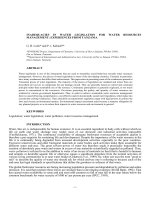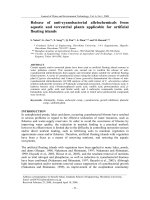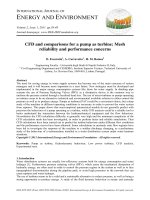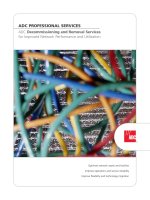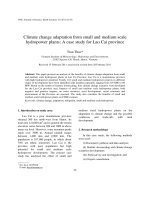Coaching for Commitment ACHIEVING SUPERIOR PERFORMANCE FROM INDIVIDUALS AND TEAMS docx
Bạn đang xem bản rút gọn của tài liệu. Xem và tải ngay bản đầy đủ của tài liệu tại đây (5.2 MB, 274 trang )
Coaching for
Commitment
ACHIEVING SUPERIOR
PERFORMANCE FROM
INDIVIDUALS AND TEAMS
THIRD EDITION
Cindy Coe
Amy Zehnder
Dennis Kinlaw
John Wiley & Sons, Inc.
ffirs.indd vffirs.indd v 9/28/07 2:01:28 PM9/28/07 2:01:28 PM
ffirs.indd iiffirs.indd ii 9/28/07 2:01:27 PM9/28/07 2:01:27 PM
About This Book
Why is this topic important?
The return on investment for coaching is multiple times the initial investment,
and the payoffs are tangible: sustained superior performance and commitment to
self, organizations, and goals. The more coaching happens, the more high per-
forming individuals and teams become. Coaching is an investment in people that
leads to bottom-line results!
What can you achieve with this book?
Coaching for Commitment has something to offer to everyone. The manager who
is looking to foster independence and innovation, the executive who wants to
hone strategic and interpersonal skills, the HR professional who wants to effec-
tively develop talent, the teacher who is trying to communicate differently with
students and team members, the employee who is stuck in a rut and is looking for
growth and opportunity, the parent who is looking for a new and creative way to
interact with the kids, or the coaching professional who is looking for a new way
of re-energizing his or her coaching. This book is for the new and the novice
coach, as well as for the seasoned and savvy.
How is this book organized?
This book contains nine chapters and fi ve appendices. From commitment to
coaching and back to commitment, it is loaded with tools, examples, and sample
coaching conversations that illuminate the use of the coaching process, model,
and skills.
ffirs.indd iffirs.indd i 9/28/07 2:01:26 PM9/28/07 2:01:26 PM
ffirs.indd iiffirs.indd ii 9/28/07 2:01:27 PM9/28/07 2:01:27 PM
About Pfeiffer
Pfeiffer serves the professional development and hands-on resource needs of
training and human resource practitioners and gives them products to do their
jobs better. We deliver proven ideas and solutions from experts in HR develop-
ment and HR management, and we offer effective and customizable tools to im-
prove workplace performance. From novice to seasoned professional, Pfeiffer is
the source you can trust to make yourself and your organization more
successful.
Essential Knowledge Pfeiffer produces insightful, practical, and
comprehensive materials on topics that matter the most to training and
HR professionals. Our Essential Knowledge resources translate the expertise of
seasoned professionals into practical, how-to guidance on critical workplace
issues and problems. These resources are supported by case studies, worksheets,
and job aids and are frequently supplemented with CD-ROMs, websites, and
other means of making the content easier to read, understand, and use.
Essential Tools Pfeiffer’s Essential Tools resources save time and
expense by offering proven, ready-to-use materials—including exercises,
activities, games, instruments, and assessments—for use during a training or
team-learning event. These resources are frequently offered in looseleaf or CD-
ROM format to facilitate copying and customization of the material.
Pfeiffer also recognizes the remarkable power of new technologies in ex-
panding the reach and effectiveness of training. While e-hype has often created
whizbang solutions in search of a problem, we are dedicated to bringing con-
venience and enhancements to proven training solutions. All our e-tools comply
with rigorous functionality standards. The most appropriate technology wrapped
around essential content yields the perfect solution for today’s on-the-go train-
ers and human resource professionals.
Essential resources for training and HR professionals
www.pfeiffer.com
ffirs.indd iiiffirs.indd iii 9/28/07 2:01:27 PM9/28/07 2:01:27 PM
This book is dedicated to Tammy Zehnder,
our special angel, whose celestial presence
continues to make it possible for us
to fi nish projects like these,
while still fi nding time to dance in the rain,
play in the snow, and celebrate that life is good!
ffirs.indd ivffirs.indd iv 9/28/07 2:01:28 PM9/28/07 2:01:28 PM
Coaching for
Commitment
ACHIEVING SUPERIOR
PERFORMANCE FROM
INDIVIDUALS AND TEAMS
THIRD EDITION
Cindy Coe
Amy Zehnder
Dennis Kinlaw
John Wiley & Sons, Inc.
ffirs.indd vffirs.indd v 9/28/07 2:01:28 PM9/28/07 2:01:28 PM
Copyright © 2008 by John Wiley & Sons, Inc. All Rights Reserved.
Published by Pfeiffer
An Imprint of Wiley
989 Market Street, San Francisco, CA 94103-1741
www.pfeiffer.com
No part of this publication may be reproduced, stored in a retrieval system, or transmitted in
any form or by any means, electronic, mechanical, photocopying, recording, scanning, or
otherwise, except as permitted under Section 107 or 108 of the 1976 United States Copyright
Act, without either the prior written permission of the Publisher, or authorization through
payment of the appropriate per-copy fee to the Copyright Clearance Center, Inc., 222
Rosewood Drive, Danvers, MA 01923, 978-750-8400, fax 978-646-8600, or on the web at
www.copyright.com. Requests to the Publisher for permission should be addressed to the
Permissions Department, John Wiley & Sons, Inc., 111 River Street, Hoboken, NJ 07030,
201-748-6011, fax 201-748-6008, or online at />Limit of Liability/Disclaimer of Warranty: While the publisher and author have used their best
efforts in preparing this book, they make no representations or warranties with respect to the
accuracy or completeness of the contents of this book and specifi cally disclaim any implied
warranties of merchantability or fi tness for a particular purpose. No warranty may be created
or extended by sales representatives or written sales materials. The advice and strategies
contained herein may not be suitable for your situation. You should consult with a professional
where appropriate. Neither the publisher nor author shall be liable for any loss of profi t or any
other commercial damages, including but not limited to special, incidental, consequential,
or other damages.
Readers should be aware that Internet websites offered as citations and/or sources for further
information may have changed or disappeared between the time this was written and when it
is read.
PowerPoint is a registered trademark of the Microsoft Corporation.
For additional copies/bulk purchases of this book in the U.S. please contact 800-274-4434.
Pfeiffer books and products are available through most bookstores. To contact Pfeiffer directly
call our Customer Care Department within the U.S. at 800-274-4434, outside the U.S. at
317-572-3985, fax 317-572-4002, or visit www.pfeiffer.com.
Pfeiffer also publishes its books in a variety of electronic formats. Some content that appears in
print may not be available in electronic books.
Library of Congress Cataloging-in-Publication Data
Coe, Cindy.
Coaching for commitment : achieving superior performance from individuals and
teams / Cindy Coe, Amy Zehnder, and Dennis Kinlaw.— 3rd ed.
p. cm.
Rev. ed. of: Coaching for commitment / Dennis Kinlaw. 2nd ed. c1999.
Includes bibliographical references and index.
ISBN-13: 978-0-7879-8249-2 (cloth)
1. Personnel management. 2. Employees—Coaching of. 3. Employees—Training of.
4. Employee motivation. I. Zehnder, Amy, 1966- II. Kinlaw, Dennis C. III. Kinlaw,
Dennis C. Coaching for commitment. IV. Title.
HF5549.K498 2008
658.3’124—dc22
2007033231
Acquiring Editor: Martin Delahoussaye
Director of Development: Kathleen Dolan Davies
Developmental Editor: Susan Rachmeler
Production Editor: Dawn Kilgore
Editor: Rebecca Taff
Editorial Assistant: Julie Rodriquez
Manufacturing Supervisor: Becky Morgan
Printed in the United States of America
Printing 10 9 8 7 6 5 4 3 2 1
ffirs.indd viffirs.indd vi 9/28/07 2:01:28 PM9/28/07 2:01:28 PM
vii
CONTENTS
ACKNOWLEDGMENTS xi
PREFACE xv
INTRODUCTION 1
1. COACHING FOR COMMITMENT 7
Successful Coaching: A Working Defi nition 7
Coaching Works 9
The Meaning of Commitment 10
Building Commitment Through Coaching 13
Coaching for Commitment 21
Coaching Moment 21
Chapter Summary 22
2. THE COACH ROLE 23
Role Distinctions—What and How 24
Shift Happens! 27
Coach Role 37
Coaching Moment 52
Chapter Summary 53
ftoc.indd viiftoc.indd vii 9/28/07 6:52:47 PM9/28/07 6:52:47 PM
3. THE COACHING PROCESS 57
Coaching Prism 59
Putting the Pieces Together 61
Coaching Moment 62
Chapter Summary 63
4. TRUST 65
Establishing and Maintaining Trust 65
Coaching Moment 74
Chapter Summary 75
5. THE INDICOM COACHING MODEL 77
InDiCom Coaching Model Stage I: Involve 80
InDiCom Coaching Model Stage II: Discover 85
InDiCom Coaching Model Stage III: Commit 92
Interdependent Stages 101
Coaching Moment 102
Chapter Summary 103
6. CLEAR COACHING SKILLS 105
Challenge 107
Listen 116
Encourage 124
Ask 132
Refi ne 137
Coaching Moment 147
Chapter Summary 147
7. PLAN TO COACH 149
Performance Coaching 150
Documentation 162
viii Contents
ftoc.indd viiiftoc.indd viii 9/28/07 6:52:48 PM9/28/07 6:52:48 PM
Note-Taking 162
Coaching Channels 163
Coaching Tools 166
Coaching Moment 167
Chapter Summary 168
8. THE COMPLETE COACHING CONVERSATION 169
General Coaching—PBC’s Why 170
Performance Coaching—Coach’s Why 179
Coaching Moments 187
Coaching by Email 190
Coaching Moment 196
Chapter Summary 196
9. CREATING A COACHING FOR COMMITMENT CULTURE 197
What Does a Coaching for Commitment Culture Look Like? 198
Create a Value Proposition for Coaching 200
How to Create a Coaching for Commitment Culture 201
Gaining Commitment to a Coaching for Commitment Culture 206
Coaching Moment 211
Chapter Summary 211
FINAL NOTE 213
APPENDIX A: THIRTY-FIVE COACHING QUESTIONS 215
APPENDIX B: TWENTY REALITY CHECKS 219
APPENDIX C: TWENTY VALIDATE AND CELEBRATE 221
STATEMENTS
Contents
ix
ftoc.indd ixftoc.indd ix 9/28/07 6:52:48 PM9/28/07 6:52:48 PM
x Contents
APPENDIX D: YOUR PERSONAL COACHING FOR 223
COMMITMENT PLAN
APPENDIX E: EVALUATING YOUR COACHING 227
REFERENCES 233
INDEX 235
ABOUT THE AUTHORS 243
ftoc.indd xftoc.indd x 9/28/07 6:52:48 PM9/28/07 6:52:48 PM
xi
ACKNOWLEDGMENTS
“It’s wonderful to be blessed with more friends than time!”
— CC
F
IRST AND FOREMOST, this edition of Coaching for
Commitment would not have been possible without the
foundational work that was provided by the late Dennis C. Kinlaw.
This book is dedicated to all of the people who make our lives rich
and full, who help us to know we are blessed and to those who make
it possible for us to do what we love every day! It is because of you
that we dedicated ourselves, and a few years, to this incredible project!
We hope you may fi nd just a little of the passion we feel when we
experience the impact of coaching.
We would like to thank all of the coaching mentors we have had
who provided us with the knowledge, skills, practice, and feedback to
make us the coaches we are today. Thanks also go to all of the people
whom we have coached and whom we continue to learn from, as well
as those who have provided us with the insight and wisdom neces-
sary to take on this endeavor.
Thanks to Deborah Gay, Ph.D., for introducing us to the world of
coaching as a career and profession and for being a mentor, dear
friend, and our biggest cheerleader. More thanks go out to Pat White,
Master Certifi ed Coach (MCC) and CEO of The Spectrum Group, for
working with Amy so that she could achieve her Professional Certi-
fi ed Coach (PCC) designation through the International Coach Feder-
ation (ICF) and also for being part of the round one peer review before
fbetw.indd xifbetw.indd xi 9/28/07 2:03:07 PM9/28/07 2:03:07 PM
our fi nal draft was even complete and cohesive! Your feedback was
very valuable in our rewrites (of which there were many)!
Thank you also to our round one peer reviewers: Alison House,
O.D. (House Vision Center, Pueblo, CO), whose supportive comments
and critical eye were so helpful for us to see things from the perspec-
tive of someone new to coaching, and James Gunn (Supervisor, Clini-
cal Pastoral Education, Penrose-St. Francis Health Services, Colorado
Springs, CO), who provided us some incredible feedback delivered
with the utmost fi nesse and humor! You are all on our “we owe you
one” list! Thank you also goes to our round two fi nal draft reviewers!
A special thank you to our editor, Martin Delahoussaye of Pfeiffer,
for his interest in this revision and his belief that we were the right peo-
ple to make this merger of the minds, thoughts, and ideas possible. Our
gratitude goes also to Julie Rodriguez, editorial assistant, who made
great things happen before our round two pilot coaching workshop!
Bill Coscarelli—Professor Extraordinaire! You magically appeared
in our lives just when we needed some statistical analysis performed
on the CSI (Coaching Skills Inventory). Talk about timing! You are
amazing! Thank you so much for your contributions on this project
and we wish you much success in your own endeavors!
Thank you to the International Coach Federation for putting struc-
ture and guidance around the growing world of coaching.
We would like to thank Heidi Onsted for introducing us to Beth
Hobbs, who welcomed us into Gillette Children’s Specialty Health-
care (St. Paul, MN) and allowed us to use a large group of managers as
a “test pilot” group to perfect the two-day Coaching for Commitment
workshop! You have no idea how much those two days meant to this
entire project! It is you and the wonderful pilot group we have to thank
for the fi nal rewrite that brought all the pieces of this package together!
Thank you for your participation and insights!
Additional thanks go to the colleagues who have supported our
efforts, sent words and tokens of encouragement, and understood
our “spread thin” existence over the course of this project: Theresa,
Jeanie, Mike, Jeff, Lyle, Kao, Rose x 3, Terri, Kristin, George, Kristi,
xii Acknowledgments
fbetw.indd xiifbetw.indd xii 9/28/07 2:03:07 PM9/28/07 2:03:07 PM
Anna, D’Andrea, Janet, Patsy, Nina, Sylvia, Paula, Matthew, Laura,
Paul, Mark, Kathy, Debbie, Sue, Jane, Lorna, Karen, Laurie, Patrick,
Marshall, Kristy, and Sara. Your patience and understanding were so
appreciated!
Thank you to the dedicated group of early childhood education
professionals from Cleveland, Ohio, who have reinforced our faith in
the education system and the people who work in it. Your input pro-
vided the fi ne-tuning we needed to perfect the end product you see
today. Bliss to you!
Thank you also to the Pikes Peak Metropolitan Community Church
board of directors for your faithful prayers, comic relief, and for pro-
viding us a periodic distraction by way of facilitating your team-
building workshops! Bless you!
And fi nally, we would like to thank all of our wonderful neigh-
bors, friends, and family for encouraging us, cheering us on, knowing
when to drag us out of the house, when to leave us alone, when to
check in on us, when to feed us, and when to run interference! For
those of you who visited at your own risk during this process, we
apologize, for we were certainly not 100 percent present and accounted
for . . . There’s always next year! For those who managed to get us out
of ourselves, if only for an hour or a weekend, and those who tempted
and cajoled and kept on trying, we thank you as well. Most of all, we
thank you for your constant encouragement and for cheering us on
even in the fi nal few months when the book took on a life of its own
and consumed us. Your support and tolerance (even when you didn’t
hear from us for months on end) was incredible! Thanks to Floreen,
Elwin, Tom, Ora, Heidi, Bruce, Wendy, Gary W., Gwen, Skip, Cindy,
Larry, Martha, Bill, Karen, Doug, Gina, Tanner, Jordan, Mary Ann,
Alan, Brandon, Shelly, Gary M., Alison, Vince, Lorraine, Bettina,
Kevin, Forrestine, Rachael, Jason, Dawn, John, Fiona, Rob, Sophie,
Hans, Sally, Lynn, Hector, Bob, Jeanette, Michelle, Chris, Donyelle,
Shirley, Casey, Samir, Nerma, Mary, Cort, and anyone else we may
have inadvertently overlooked (our sincere apologies). We can come
out and play now!
Acknowledgments
xiii
fbetw.indd xiiifbetw.indd xiii 9/28/07 2:03:07 PM9/28/07 2:03:07 PM
One more very special thank you goes to guitar teacher Paul Parker
for understanding why Amy had no brain cells left to practice her
guitar during this project and who graciously agreed to postpone
many lessons. Paul, I’m ready again!
Cheers and Mahalo!
CC & Doc
Authors’ Disclaimer: In order to protect the confi dentiality of our
real clients and workshop participants, you may notice your name
used in a scenario or example in this book or in the companion work-
shop. This usage was intended as a compliment to you and does not
necessarily refl ect your actual attitudes, thoughts, comments or behav-
iors. You are simply an actor playing a role! Lights, Camera, Action . . . !
xiv
Acknowledgments
fbetw.indd xivfbetw.indd xiv 9/28/07 2:03:08 PM9/28/07 2:03:08 PM
xv
PREFACE
“This is one of the most complete coaching skills documents
I have ever read. It is written to instruct both the line manager
who wants to pick up coaching skills as well as the person
wanting to coach outside of the on-the-job setting.”
Pat White, MCC
Target Audience
This book was written with various readers in mind, including coach-
ing professionals, executives, employees, HR professionals, small
business owners, administrators, teachers, doctors, dentists, lawyers,
parents, college students, aspiring professionals, and pretty much
anyone who interacts with people.
Coaching is for anyone who has a desire to help others fi nd their
own answers and achieve goals by committing to action. “Coaching is
not just a function; it is a state of mind. ”
This book is a practical, “how to” guide to coaching for everyone
and for all kinds of coaching. Whether you are coaching face-to-face,
on the fl y (coaching moment), by phone, email, or managing a virtual
team, this book is for you!
This book is written for you: the new, old, skilled, novice, or aspir-
ing coach, and it is designed to teach you effective coaching strategies
and techniques that will assist you on your journey to becoming a
skillful coach!
How Can Coaching for Commitment Help You?
Leaders , you will fi nd in this book a philosophy of coaching, tools and
skills that can become the foundation for any initiative to make coaching
fpref.indd xvfpref.indd xv 9/28/07 2:03:41 PM9/28/07 2:03:41 PM
part of managing by objective (MBOs), an operating function for
everyone from executive to employee, and ultimately, part of the
culture in your organization.
Human resource (HR) professionals, directors, managers, and con-
sultants alike, who have responsibility for developing, delivering, or
implementing programs on coaching, this book will not only provide
the tools to improve your own coaching skills but it is also the concep-
tual basis needed to conduct coaching workshops (especially with the
corresponding Coaching for Commitment Workshop materials).
The concepts within this book are instrumental for developing talent.
Coaching professionals or executive coach es, for some time now a
demand for trained coaching professionals has been growing. Organi-
zations are hiring these professionals to coach executives and other
leaders, to help them understand various aspects of their own
performance, gain clarity about the way they conduct personal inter-
actions, understand the way they solve problems, and help them clar-
ify their own career and performance goals. HR professionals who
intend to function as professional coaches will fi nd information and
ideas that will better equip them to perform this function.
Small-to medium-sized business owners, other professionals or
aspiring professionals, and anyone else who coaches people (such
as employees, team leaders, parents, teachers, and administrators),
there are tools in this book for you as well. The coaching skills, model,
and techniques can be applied to almost anyone: students, peers,
co-workers, patients, staff, family members, and friends.
Third Edition Enhancements
In the very fi rst edition of Coaching for Commitment: Managerial Strate-
gies for Obtaining Superior Performance , authored by Dennis Kinlaw and
published in 1989, the primary need at the time was to help managers
and supervisors recognize coaching as one of their most important
functions and to give them a tool to become successful coaches. In
1999, when the second edition of Coaching for Commitment was
xvi Preface
fpref.indd xvifpref.indd xvi 9/28/07 2:03:41 PM9/28/07 2:03:41 PM
published, the focus had shifted to an employee-centric viewpoint
wherein empowered employees were expected to operate as leaders,
thus shifting the focus of coaching to include every member of an
organization to act as a coach to others.
This third edition of Coaching for Commitment: Achieving Superior
Performance from Individuals and Teams takes all of the foundational
work of coaching that was created by Dennis Kinlaw and expands it
into a pure coaching approach, as defi ned by the latest coaching strat-
egies and methodologies. Since 1999, coaching has not only become
highly popular as a leadership practice, but has become a highly
sought after profession. As the world of coaching grew, so did its
regulatory counterparts. Now, coaching is professionalized by organi-
zations such as the International Coach Federation ( www.coachfeder-
ation.org ). Accredited coaching schools have emerged to teach
coaching skills and to provide insight on effective coaching practices
and strategies. Coaching for Commitment: Achieving Superior Performance
from Individuals and Teams has been enhanced to include new coaching
competencies, methodologies, and successful strategies that will assist
you in becoming a skillful coach. It provides information on the latest
defi nitions of what coaching is and ways to be successful as a coach.
Furthermore, and with all due respect to Dennis Kinlaw, who has
since passed away, two new authors are introduced with this revision:
Cindy Coe and Amy Zehnder. The majority of concepts in this edition
had their genesis in Kinlaw’s original work. Our goal as the new
authors was to keep the merger of authors relatively seamless to the
reader and to keep Kinlaw’s Coaching for Commitment legacy alive.
To accomplish this goal, all of the material from the second edition
was thoroughly revised into a more logical sequence with more visual
representation and fully updated to refl ect current coaching trends.
Many of the original concepts from the second edition are embedded
throughout this edition with signifi cant enhancements.
Occasionally, specifi c examples, quotes, or experiences are high-
lighted as Kinlaw’s work, and hence he will be referred to in the third
person.
Preface
xvii
fpref.indd xviifpref.indd xvii 9/28/07 2:03:42 PM9/28/07 2:03:42 PM
Dennis Kinlaw made the tie between coaching and commitment
more obvious in his second edition; this edition takes it one
step further and makes commitment a part of the coaching
model. This reaffi rms that coaching is a powerful strategy for
strengthening the commitment of people to do their level best
at all times.
One major modifi cation is how the person being coached is
referred to. There has always been confusion in this area, and
historically there have been many names for the person being
coached (client, coachee, team member, etc.). For this book, its
companion assessment and training workshop, the person(s)
being coached, whether it is a single person or multiple people,
will be called the PBC . In most cases throughout the text,
“person being coached (PBC)” will be used for the fi rst use only
in each chapter with the PBC acronym being used for the
remainder of the chapter. In some cases the plural acronym
“PBCs” will be used. “You,” on the other hand, is used to make
reference to your role as the coach . Thus, when certain compo-
nents and skills are addressed to you , we are referring to you, as
the coach .
In Chapter 1 , the Coaching for Commitment philosophy was
brought up-to-date and made more relevant for the times and
today’s world of business, leadership, and coaching.
Kinlaw introduced counseling, mentoring, confronting and
challenging, and tutoring as types of coaching in the second
edition. In Chapter 2 , this edition is distinctly different from
others in its use of roles versus types or styles of coaching.
Here, there is only one role where coaching occurs, which is
called the coach role . If you are not coaching, you are in a
different role. The coach role is introduced to better differentiate
between various other roles that people play in the workplace.
The new roles refl ect more relevant terms being used by and
recognized in the corporate and regulatory world today. A role
•
•
•
•
xviii Preface
fpref.indd xviiifpref.indd xviii 9/28/07 2:03:42 PM9/28/07 2:03:42 PM
model graphic delineates these roles of manager, instructor, mentor,
and coach . Your tendencies to gravitate to each role are measured
with the new CSI (Coaching Skills Inventory) and represented
visually using the role model graphic.
T h e manager role is new to this edition, as people have
recently begun to question how their roles as managers
differ from the coach role . Therefore, this edition clearly
differentiates between the two roles.
Kinlaw’s tutoring was changed to the instructor role. The term
instructor is more accurate in describing the nature of this role
and is also more relevant to today’s business climate.
Kinlaw’s mentoring is retained as a role and will hereafter be
referred to as the mentor role.
Kinlaw’s former confronting and challenging are recognized
most commonly in organizations as “performance coaching
conversations.” Today, the word confronting (or confronta-
tion), when used in organizations, carries a very negative
connotation, and the word challenging in the coaching world
is more in line with making requests that stretch people
beyond normal limits—which is sometimes appropriate in
the performance improvement conversation and is also
applicable to all other coaching conversations . Because of this,
confronting and challenging is no longer used as a type of
coaching or a role. There is, however, a section on Perform-
ance Coaching in Chapter 7 , and the techniques identifi ed
by Kinlaw have been incorporated in the new CLEAR
coaching skills.
Finally, counseling can no longer be called a type of coach-
ing due to recent regulatory controversy. Over the past few
years, the process of making distinctions for what coaching
is and is not has become a matter of great discussion. Many
of us in the coaching profession contend that our role is
clearly set apart from other vocations such as consulting,
Preface
xix
fpref.indd xixfpref.indd xix 9/28/07 2:03:42 PM9/28/07 2:03:42 PM
counseling, and psychotherapy. The coaching industry as a
whole is also very clear that coaching is not therapy. How-
ever, the topics of counseling and therapy have received a
lot of attention from coaching schools and coaching govern-
ing boards, as well as psychological governing boards, in
recent years. Because of this scrutiny and controversy in
distinguishing coaching from therapy and counseling, this
edition does not use Kinlaw’s counseling, thus eliminating
any close ties to the therapeutic world because coaching is
not therapy. This topic is discussed in greater detail in
Chapter 2 .
In Chapter 3 , the biggest addition to this book comes in the
form of a visual representation of the entire coaching process,
which is now inclusive of a coaching model and skills.
A Coaching Prism visual was created to illustrate how all of
the coaching components come together to create successful
coaching conversations; included in the chapter are the ele-
ments of trust, the InDiCom coaching model, and CLEAR
coaching skills. Trust is more than a skill. It is considered the
key component of all successful coaching conversations and
essential throughout all stages of the coaching model. Because
of this, it has been given a chapter of its own (Chapter 4 ) and is
no longer recognized as one of Kinlaw’s general skills, former-
ly referred to as Indicating Respect.
In Chapter 5 , Kinlaw’s two coaching processes (Responding to
Needs and Initiating Alternatives) were merged into one coach-
ing model called InDiCom. Between the fi rst and second editions,
Kinlaw simplifi ed his two models; moving to one model in this
third edition simplifi es things even further. The reason for
this modifi cation is that all of Kinlaw’s types of coaching from
the second edition—counseling, mentoring, confronting, and
tutoring—employ the same core skills and move through the
same coaching process. They differ only in the initial approach.
•
•
xx Preface
fpref.indd xxfpref.indd xx 9/28/07 2:03:43 PM9/28/07 2:03:43 PM
The new InDiCom Coaching Model consists of three stages:
Involve, Discover, and Commit.
Chapter 6 debuts the new CLEAR coaching skills, which can be
used in all stages of the InDiCom coaching model. Kinlaw’s
general coaching skills were redefi ned, combined, and turned
into the coaching skills acronym—CLEAR.
Plan to Coach, Chapter 7 , details how to plan for and conduct
performance coaching conversations and provides an in-depth
discussion of the various coaching channels (face-to-face and
virtual) that can be used to conduct your coaching
conversations.
Chapter 8 is devoted to all new, extended coaching conversa-
tion samples. These examples support the Coaching Prism,
InDiCom coaching model, and CLEAR coaching skills. There
are also two coaching moment examples as well as one email
coaching example. These examples demonstrate that coaching
can occur using just about any means and that it is a function
for everyone—not just appointed leaders in organizations!
In Chapter 9 , Creating a Coaching for Commitment Culture,
the scope of coaching remains consistent in that coaching is
seen as a function that can and should be performed by all
persons at all levels in all organizations, rather than just a
function for managers, supervisors, and other leaders. This
new Creating a Coaching for Commitment Culture chapter
focuses on how anyone can create a coaching culture that is
reciprocal in nature and extensible to the entire organization—
even if it starts with one team. This is based on the premise
that superior teams are characterized by leaders who are
perceived and valued as good coaches and that, in instances in
which team development and team performance have fulfi lled
expectations, you can expect to fi nd team leaders and employees
spending a good bit of their time coaching one another and
coaching their teams. For this to occur, fi rst the leader must
•
•
•
•
Preface
xxi
fpref.indd xxifpref.indd xxi 9/28/07 2:03:43 PM9/28/07 2:03:43 PM
create the conditions that foster a coaching for commitment
culture, which includes educating and providing resources
(such as this book or the Coaching for Commitment Discussion
Guide ) to team members about coaching and its components, as
well as modeling the way. Even if you are not in a position to
infl uence your entire organization or its leaders, you can
commit to Creating a Coaching for Commitment Culture for
those within your scope of infl uence. A new guide was created
and included in this chapter to help you create a Coaching for
Commitment action plan.
Additional Coaching for Commitment
Components
In addition to revising this book, revisions were also made to other
components of the package. Each of these items can be purchased
through Pfeiffer ( www.pfeiffer.com ). Some can be purchased as a
package.
Two-Day Coach Training Workshop
The workshop contains a fully revised, interactive, experiential, and
comprehensive two-day training program on the Coaching for Commit-
ment content with extensions to apply it to the real world of business
and coaching. The workshop components are:
Facilitator’s Guide
Participant Workbook
DVD/video of coaching samples
CD-ROM, which contains a slide presentation and supplemen-
tal materials
Coaching Skills Inventory: Self
•
•
•
•
•
xxii Preface
fpref.indd xxiifpref.indd xxii 9/28/07 2:03:43 PM9/28/07 2:03:43 PM
Coaching Skills Inventory: Observer
Discussion Guide
The last three items are described in more detail next.
Coaching Skills Inventory ( CSI )
The Coaching Skills Inventory (CSI) contains three components:
CSI: Self-Assessment
CSI: Observer Assessment
CSI Administrator’s Guide
The CSI: Self has been changed to identify (1) a coaching gap com-
pared to an ideal, (2) the role(s) you gravitate toward, and (3) profi -
ciency levels in using certain coaching skills during interactions with
others. We recommend taking the assessment before you read this
book. It will provide you with a great starting point for your
reading.
The CSI also has a 360-degree feedback component. Use the CSI:
Observer to get a holistic view of the behaviors and actions you exhibit.
For a full 360-degree view, obtain an observer assessment from your
boss, three direct reports (if applicable), and three others. Depending
on the nature of your work and/or your purpose in using this inven-
tory, “others” may include peers, partners, vendors, customers, or stu-
dents. The CSI: Observer also makes a great follow-up assessment to
check your progress.
The CSI Administrator’s Guide is designed to assist anyone who is
administering the CSI as part of the Coaching for Commitment work-
shop, as part of another leadership or coaching program, or as a
stand-alone assessment. Thus, this Guide is sold separately from the
workshop package.
Coaching for Commitment Discussion Guide
Are you planning to create a Coaching for Commitment culture or
simply help others to understand what Coaching for Commitment
•
•
•
•
•
Preface
xxiii
fpref.indd xxiiifpref.indd xxiii 9/28/07 2:03:43 PM9/28/07 2:03:43 PM

